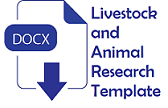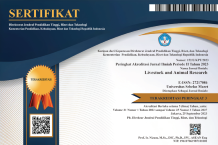Supplementation of growth enhancer on Ongole grade cattle: effects on nutrient utilization, and growth performance
Abstract
Objective: This experiment aimed to assess natural growth enhancers supplementation on nutrient metabolism and production performance of Ongole grade cattle.
Methods: The solid growth enhancer (GE) was formulated to contain highly soluble energy sources (molasses), nitrogen (urea), bypass protein (dried-Leucaena leaves and soybean meal), polyunsaturated fatty acids (fish oil), phytonutrient-rich source (T. catappa), and mineral premix. In total, 25 Ongole grade cattle at 1-1.5 years in age averaged 150 ± 12 kg of initial body weight were distributed to receive five dietary treatments as follow: P0 = basal diet; P1 = P0 + 5 g/kg BW0.75 GE; P2 = P0 + 10 g/kg BW0.75 GE; P3 = P0 + 20 g/kg BW0.75 GE; P4 = PO + 30 g/kg BW0.75 GE, respectively, (5 replicates per treatment). The experiment lasted 10 months.
Results: GE supplementation at 5g/kg BW0.75 (P1) significantly increased daily gain and final BW compared to P0 (P<0.05). Voluntary intake for dry matter, crude protein, and total digestible nutrient increased for cattle fed diets containing GE (P<0.05) compared to P0 but no difference among supplementary levels (P>0.05). Digestibility of DM and CF were significantly higher at P1 t (P<0.05) while N retention was highest on P1 and P2 and P0 was the lowest (P<0.05). Cattle fed with P1 and P2 treatments excreted higher allantoin and uric acid thus produced higher microbial protein synthesis than other treatments (P<0.05).
Conclusions: In conclusion, dietary GE increased nutrient density of the ration and supplementation at 5g/kg BW0.75 could increase voluntary intake and nutrient utilization, and thus increased performance parameters of Ongole grade cattle.
Keywords
Full Text:
PDFReferences
- O’Hara, E., A. L. A. Neves, Y. Song, and L. L. Guan. 2020. The role of the gut microbiome in cattle production and health: driver or passenger? Annu. Rev. Anim. Biosci. 8:199–220. Doi: 10.1146/ annurev-animal-021419-083952
- Cherdthong, A., C. Suntara, W. Khota, and M. Wanapat. 2021. Feed utilization and rumen fermentation characteristics of Thai-indigenous beef cattle fed ensiled rice straw with Lactobacillus casei TH14, molasses, and cellulase enzymes. Livest. Sci. 245:104405. Doi: 10.1016/j.livsci.2021. 104405
- Riswandi, A. I. M. Ali, Muhakka, Y. Syaifudin, and I. Akbar. 2015. Nutrient digestibility and productivity of Bali cattle fed fermented Hymenachne amplexiacalis based rations supplemented with Leucaena leucocephala. Media Peternak. 38(3):156–162. Doi: 10.5398/medpet.2015.38.3.156
- Cock, I. E. 2015. The medicinal properties and phytochemistry of plants of the genus Terminalia (Combretaceae). Inflammopharmacology. 23(5):203–229. Doi: 10.1007/s10787-015-0246-z
- Irawan, A., C. T. Noviandi, Kustantinah, B. P. Widyobroto, A. Astuti, and S. Ates. 2021. Effect of Leucaena leucocephala and corn oil on ruminal fermentation, methane production and fatty acid profile: An in vitro study. Anim. Prod. Sci. 61(5):459–469. Doi: 10.1071/AN20003
- Gaviria-Uribe, X., D. M. Bolivar, T. S. Rosenstock, I. C. Molina-Botero, N. Chirinda, R. Barahona, and J. Arango. 2020. Nutritional quality, voluntary intake and enteric methane emissions of diets based on novel Cayman grass and its associations with two Leucaena shrub legumes. Front. Vet. Sci. 7. Doi: 10.3389/fvets.2020.579189
- Piñeiro-Vázquez, A. T., J. R. Canul-solis, G. Jiménez-Ferrer, J. A. Alayón-Gamboa, A. J. Chay-Canul, A. J. Ayala-Burgos, C. F. Aguilar-Pérez, and J. C. Ku-Vera. 2018. Effect of condensed tannins from Leucaena leucocephala on rumen fermentation, methane production and population of rumen protozoa in heifers fed low-quality forage. Asian-Australasian J. Anim. Sci. 31(11):1738–1746. Doi: 10.5713/ajas.17.0192
- Phesatcha, B., B. Viennasay, and M. Wanapat. 2021. Potential use of Flemingia (Flemingia macrophylla) as a protein source fodder to improve nutrients digestibility, ruminal fermentation efficiency in beef cattle. Anim. Biosci. 34(4):613–620. Doi: 10.5713/ajas.20.0214
- Ferreira, E. M., A. V. Pires, I. Susin, M. V. Biehl, R. S. Gentil, M. de O. M. Parente, D. M. Polizel, C. Vaz Di Mambro Ribeiro, and E. de Almeida. 2016. Nutrient digestibility and ruminal fatty acid metabolism in lambs supplemented with soybean oil partially replaced by fish oil blend. Anim. Feed Sci. Technol. 216:30–39. Doi: 10.1016/ j.anifeedsci.2015.09.007.
- Pirondini, M., S. Colombini, M. Mele, L. Malagutti, L. Rapetti, G. Galassi, and G. M. Crovetto. 2015. Effect of dietary starch concentration and fish oil supplementation on milk yield and composition, diet digestibility, and methane emissions in lactating dairy cows. J. Dairy Sci. 98(1):357–372. Doi: 10.3168/jds.2014-8092
- Kostenbauder, M. J., S. W. Coleman, C. C. Chase, W. E. Kunkle, M. B. Hall, and F. G. Martin. 2007. Intake and digestibility of bahiagrass hay by cattle that are supplemented with molasses or molasses-urea with or without soybean hulls. Prof. Anim. Sci. 23(4):373–380. Doi: 10.15232/S1080-7446(15)30991-8
- Khattab, I. M., A. Z. M. Salem, A. M. Abdel-Wahed, and K. Z. Kewan. 2013. Effects of urea supplementation on nutrient digestibility, nitrogen utilisation and rumen fermentation in sheep fed diets containing dates. Livest. Sci. 155(2-3):223–229. Doi: 10.1016/j.livsci.2013.05.024
- Dagaew, G., A. Cherdthong, M. Wanapat, and S. So. 2021. Ruminal fermentation, milk production efficiency, and nutrient digestibility of lactating dairy cows receiving fresh cassava root and solid feed-block containing high sulfur. Fermentation. 7(3):114. Doi: 10.3390/fermentation7030114
- Hartadi, H., S. Reksohadiprodjo dan A. D. Tillman. 1980. Tabel komposisi Pakan untuk Indonesia. Gadjah Mada University Press, Yogyakarta.
- AOAC. 2005. Official methods of analysis of AOAC International. 18th ed. Assoc. Off. Anal. Chem., Arlington.
- Chen, X. B., and J. Gomes. 1992. Estimation of microbial protein supply to sheep and cattle details. (I. F. R. U. R. R. Institute, editor.). Bucksburn Aberdeen, UK.
- Pamungkas, D., F. Firdaus, L. Affandhy, and M. Luthfi. 2019. Mineral-Vitamin combining versus herbal supplementationto enhance performance Ongole crossbred bull. IOP Conf. Ser. Earth Environ. Sci. 372(1):012058. Doi: 10.1088/1755-1315/372/1/012058
- Faiz, A., M. Azmi, F. M. Amin, H. Ahmad, N. M. Nor, G. Y. Meng, M. Z. Saad, Z. A. Bakar, P. Abdullah, A. Irawan, A. Jayanegara, and H. A. Hassim. 2021. Effects of bypass fat on buffalo carcass characteristics, meat nutrient contents and profitability. Animals. 11(11):3042. Doi: 10.3390/ani11113042
- Mordenti, A. L., E. Giaretta, L. Campidonico, P. Parazza, and A. Formigoni. 2021. A review regarding the use of molasses in animal nutrition. Animals. 11(1):115. Doi: 10.3390/ani11010115
- Torres, R. de N. S., J. P. A. Bertoco, M. C. G. de Arruda, L. de M. Coelho, J. R. Paschoaloto, G. A. de A. Júnior, J. M. B. Ezequiel, and M. T. C. Almeida. 2021. Meta-analysis to evaluate the effect of including molasses in the diet for dairy cows on performance, milk fat synthesis and milk fatty acid. Livest. Sci. 250:104551. Doi: 10.1016/j.livsci.2021.104551
- Havekes, C. D., T. F. Duffield, A. J. Carpenter, and T. J. DeVries. 2020. Effects of molasses-based liquid feed supplementation to a high-straw dry cow diet on feed intake, health, and performance of dairy cows across the transition period. J. Dairy Sci. 103(6):5070–5089. Doi: 10.3168/jds.2019-18085
- Wanapat, M., S. Kang, P. Khejornsart, and R. Pilajun. 2013. Improvement of whole crop rice silage nutritive value and rumen degradability by molasses and urea supplementation. Trop. Anim. Health Prod. 45(8):1777–1781. Doi: 10.1007/s11250-013-0433-0
- Petty, S. R., and D. P. Poppi. 2012. The liveweight gain response of heifers to supplements of molasses or maize while grazing irrigated Leucaena leucocephala/ Digitaria eriantha pastures in north-west Australia. Anim. Prod. Sci. 52(7):619–623. Doi: 10.1071/AN11242
- Ojo, V. O. A., A. B. J. Aina, O. A. Fasae, A. O. Oni, R. Y. Aderinboye, P. A. Dele, O. J. Idowu, O. O. Adelusi, O. O. Shittu, F. A. Okeniyi, F. A. Okeniyi, and A. O. Jolaosho. 2014. Effects of supplementing Leucaena leucocephala and conserved forages from natural pasture on the performance of grazing calves. Trop. Anim. Health Prod. 46(1):197–202. Doi: 10.1007/s11250-013-0476-2
- Soltan, Y. A., A. S. Morsy, S. M. A. Sallam, R. C. Lucas, H. Louvandini, M. Kreuzer, and A. L. Abdalla. 2013. Contribution of condensed tannins and mimosine to the methane mitigation caused by feeding Leucaena leucocephala. Arch. Anim. Nutr. 67(3):169–184. Doi: 10.1080/1745039X.2013.801139
- Noviandi, C. T., K. Kustaantinah, A. Irawan, B. P. Widyobroto, and A. Astuti. 2021. Determination of in vitro gas production kinetics by adding Leucaena leucecophala and corn oil to the ration in different ratios. Iran. J. Appl. Anim. Sci. 11(1):23–31.
- Barros-Rodríguez, M., C. A. Sandoval-Castro, J. Solorio-Sánchez, L. A. Sarmiento-Franco, R. Rojas-Herrera, and A. V Klieve. 2014. Leucaena leucocephala in ruminant nutrition. Trop. Subtrop. Agroecosystems. 17(2):173–183.
- Sarwar, M., M. A. Shahzad, M. U. Nisa, D. Afzal, M. Sharif, and H. A. Saddiqi. 2011. Feeding value of urea molasses-treated wheat straw ensiled with fresh cattle manure for growing crossbred cattle calves. Trop. Anim. Health Prod. 43(3):543–548. Doi: 10.1007/s11250-010-9745-5
- Sowmya, T. N. and K. A. Raveesha. 2021. Polyphenol-Rich purified bioactive fraction isolated from Terminalia catappa L.: UHPLC-MS/MS-Based metabolite identification and evaluation of their antimicrobial potential. Coatings. 11(1):1210. Doi: 10.3390/coatings111 01210
- Olagaray, K. E. and B. J. Bradford. 2019. Plant flavonoids to improve productivity of ruminants – A review. Anim. Feed Sci. Technol. 251:21–36. Doi: 10.1016/j.anifeedsci.2019.02.004
Refbacks
- There are currently no refbacks.










